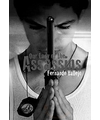Streets Lined with Blood
The movie from this week La virgen de los sicaros, was a very intense look at the recurring problems in Columbia because of the drug trafficking there. It shows what the actual repercussions are on the individual people living there. The biggest way it does this is through generational gaps that show the changing society in Columbia especially in the city of Medellin. The older man Fernando knew what the city was like before the drug cartels took over. He is able to tell the story of his humble childhood. In comparison the boys Alexis and Wilmar show him the city that they are growing up in; a city where the streets, houses, and even more extremely the churches are not safe. The churches are now a place where cocaine is sold and taken. It is where deals go down and people use their religion to kill in the name of what they sell. Where little children sniff glue to the point that there bodies become lifeless. Also to these children who have more harsh experiences than most adults, death is a common occurrence. The killing of another is just a way to stake your claim of what you want. If someone looks at you the wrong way they can be shot. What is the most shocking at the end of the movie is when Fernando goes into the morgue and all of the boys around the same age are lying there. Wilmar has died but before him Alexis was killed because he killed his brother and many more before him. Their lives lost. It gives the example that a whole generation is being wiped out in this same manner of one for another. One death just leads to another. Another very important aspect of the film is the symbolism. One scene in particular is after Fernando goes and visits Alexis’ family. He is walking down the stairs and it begins to rain. The rain-washed away tons and tons of blood. It comes down the stairs and through the gutters. This is symbolic of that every household in the ghetto of Medellin has had cold-blooded murder. They all have lost young men. This bloodshed has covered the streets till that is all that is recognizable.
The first set of documents for this week, which were from the National Security Archive, discussed the United States role with funding and backing the Columbian military in 2003 immediately after the death of potential candidate Luis Carlos Galan by the Medellin drug cartel. These specific documents and the ones that follow show that the United States was only committed to funding the military when they were working at counter-drug activities. The United States was able to work under the label that they were helping to fight the guerrillas that were undermining the government in Columbia. But, there was always specific interest in the guerrillas that were working with the drug cartels. Specifically when they began to attack areas where the growers were specifically being targeted. The United States even switched from funding the government to funding a police force that they felt were busting the cartels more efficiently than the military. The United States was aware of the human rights violations of the army and in some cases was not willing to turn the other check to what was actually going on.
Ricardo Vargas’ article explains how mafia type groups are able to flourish in countries. He explains that there are certain situations within societies that fuel the existence of this. All of the examples that they give are what is occurring in Medellin. One of the parts of this is control over the city that develops because of a lack of government restrictions. The society creates a form of court and execution system develops outside of the one that already exists. This has occurred within Medellin. The system of control has now been placed on gangs that shoot out one another. Another example from the movie is how when a shipment of cocaine is processed into the United States fireworks go off. This shows the institutionalized weight that cocaine as an export has on the city. It was important for the whole city to know when it occurred.
matteavs

